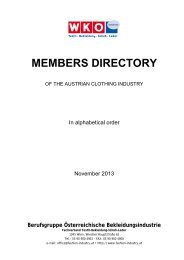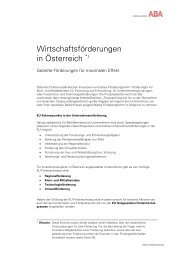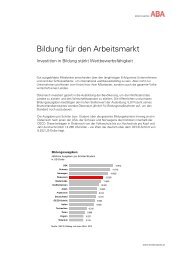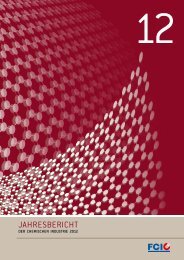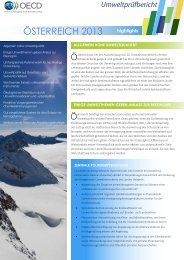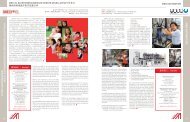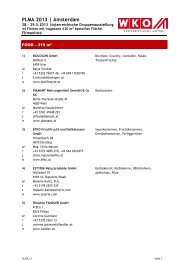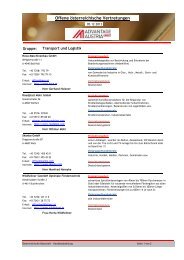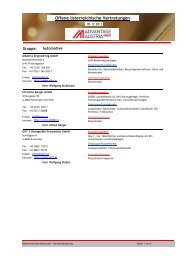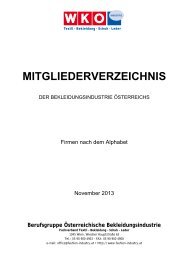AE Lebensmittel_ok.indd - Advantageaustria.org
AE Lebensmittel_ok.indd - Advantageaustria.org
AE Lebensmittel_ok.indd - Advantageaustria.org
Sie wollen auch ein ePaper? Erhöhen Sie die Reichweite Ihrer Titel.
YUMPU macht aus Druck-PDFs automatisch weboptimierte ePaper, die Google liebt.
AUSTRI<strong>AE</strong>XPORT<br />
clude energy drinks, soft drinks and iced-tea drinks, traditional<br />
Austrian confections, pastries and similar sweet<br />
delights. However, the overriding theme in exports is<br />
health and nutrition, which helps domestic exporters<br />
make plans. Thanks to the excellent positioning of<br />
Austria’s agricultural and food products and the increase<br />
in purchasing power around the world, AMA and the professional<br />
association of the food industry see a bright future<br />
for Austrian food. While Germany and Italy are the<br />
country’s most important trade partners by far, the export<br />
markets of south-eastern Europe have a great deal of potential:<br />
exports to that part of the world grew by 8.4%, to<br />
470 mn euros, in six months.<br />
While meat and meat products from Austria are<br />
particularly popular there, signifi cant improvement has<br />
been observed with milk and dairy products. There was<br />
a 43% increase in exports from Austria to the new EU<br />
member countries compared to nearly zero growth in<br />
imports.<br />
Hungary, the land of salami<br />
Approximately one fourth of all Austrian exports to eastern<br />
Europe are destined for Hungary. The fact that Austrian<br />
meat and sausage has seen growth of 47.8% in the<br />
“land of salami” is worthy of note. The trend has been<br />
similar in the Czech Republic (+45%), though Austrian<br />
milk (+95.2%) and cheese (+19.3%) are even more popular<br />
there. Exports to the 12 new EU countries, after starting<br />
at a lower level, increased 8.4% more than those to<br />
the “old” 15 EU members (+7.4%), though last year’s fi -<br />
gure was extremely high. At the same time, exports to the<br />
old EU have quadrupled since 1995.<br />
Austria’s most important partner for agricultural trade<br />
remains, however, Germany. Exports in the fi rst half of<br />
2007 continued to be extremely strong, climbing an additional<br />
5.6%. Austria exported goods valued at 1.06 bn euros<br />
to Germany, milk and dairy products, including<br />
cheese, and meat being in the highest demand. Exports of<br />
butter gained by 86.1%.<br />
Exports in the fi rst half of 2007 amounted to 3.42 bn<br />
euros, and imports were valued at 3.48 bn (+6.7%). In<br />
other words, the agricultural economy is almost evenly<br />
balanced.<br />
After successful launches in Central and East Europe,<br />
the export initiative now focuses on such foreign markets<br />
as the USA, China and the Arab countries. For example,<br />
Shanghai’s Food and Hospitality (FHC), Asia’s largest<br />
trade fair for food, was held in mid-November 2007, and<br />
Austria participated for the third time with a joint stand.<br />
A total of 12 companies put their jam, vinegar, chocolate,<br />
dairy products, snacks and wine on display. In addition,<br />
Austrian food weeks at Shanghai’s leading supermarket<br />
chain for imported food, the Shanghai City Shop. This<br />
gave Austrian companies an opportunity to present their<br />
food products, in accordance with the growing demand<br />
for Western products in China. On 18 November 2007,<br />
the fi rst presentation of food to<strong>ok</strong> place in Dubai, U<strong>AE</strong>,<br />
and the products of 22 Austrian companies were there.<br />
Österreich exportiert fast fünfmal so viel Rindfl eisch in die<br />
EU-15, wie es importiert. Bei den Verarbeitungserzeugnissen<br />
zählen Energy Drinks, Limonaden und Eistees, österreichische<br />
Süßwaren sowie Feinbackwaren und Spezialitäten<br />
aus der Mehlspeisküche zu den Exportkaisern. „Megathema“<br />
im Export sind Gesundheit und Ernährung, was den heimischen<br />
Exporteuren Orientierung gebe. Aufgrund der guten<br />
Positionierung der heimischen Agrar- und Nahrungsmittelprodukte<br />
sowie der global steigenden Kaufkraft sehen AMA<br />
und Lebens mittel-Fachverband nach wie vor große Chancen<br />
für Austro-Food. Deutschland und Italien sind zwar<br />
mit Abstand die größten Handelspartner, Potenzial gebe es<br />
aber vor allem noch in den Exportmärkten Südosteuropas,<br />
wo die Exporte im Halbjahr um 8,4 Prozent auf 470 Mio.<br />
Euro zulegten.<br />
Gefragt sind dort Fleisch und Fleischzubereitungen aus<br />
Österreich. Aber auch im Milchbereich seien deutliche Veränderungen<br />
zu bemerken: Einem Exportplus von 43 Prozent<br />
aus Österreich in die neuen EU-Staaten stehe nahezu<br />
ein Null-Wachstum bei den Importen gegenüber.<br />
„Salami-Land Ungarn“<br />
Rund ein Viertel aller Ost-Exporte aus Österreich geht nach<br />
Ungarn. Beachtlich erscheint, dass ausgerechnet in das<br />
„Salami-Land Ungarn“ österreichische Fleisch- und Wurstspezialitäten<br />
mit einem Plus von 47,8 Prozent zu Buche<br />
schlagen. Ähnlich entwickelt sich dieses Segment in Tschechien<br />
(+45 %). Noch beliebter sind dort nur mehr österreichische<br />
Milch (+95,2 %) und Käse (+19,3 %). Der Export<br />
in die zwölf neuen EU-Länder entwickelt sich – von einem<br />
niedrigeren Niveau ausgehend – mit plus 8,4 Prozent besser<br />
als in die alten 15 EU-Länder (+7,4 %), dort allerdings von<br />
sehr hohem Vorjahresniveau startend. Seit 1995 haben sich<br />
die Exporte in die „alte“ EU aber dennoch ver vierfacht.<br />
Österreichs wichtigster Agrarhandelspartner ist und<br />
bleibt Deutschland. Auf sehr hohem Niveau sind die Exporte<br />
im ersten Halbjahr 2007 um weitere 5,6 Prozent gestiegen.<br />
Österreich exportierte in diesem Zeitraum Waren im<br />
Wert von 1,06 Mrd. Euro nach Deutschland, wobei vor<br />
allem Fleisch sowie Milch und Milchprodukte inklusive<br />
Käse gefragt sind. Vor allem Butter hat um 86,1 Prozent<br />
zugelegt.<br />
Exporten von 3,42 Mrd. Euro standen im ersten Halbjahr<br />
2007 Importe von 3,48 Mrd. Euro gegenüber (+6,7 %).<br />
Die Agrarbilanz ist damit fast ausgeglichen.<br />
Nach den erfolgreichen Marktauftritten in Mittel- und<br />
Osteuropa liegt der Schwerpunkt der Exportinitiative jetzt<br />
auf Überseemärkten wie den USA, China oder dem arabischen<br />
Raum. So fand Mitte November 2007 in Shanghai<br />
mit der „Food and Hospitality“ (FHC) die größte <strong>Lebensmittel</strong>messe<br />
Asiens statt, und Österreich präsentierte sich<br />
dort bereits zum dritten Mal mit einem Gruppenstand:<br />
Zwölf Firmen boten Marmelade, Essig, Sch<strong>ok</strong>olade, Milchprodukte,<br />
Knabbereien und Wein an. Weiters fanden in der<br />
führenden Supermarktkette für importierte <strong>Lebensmittel</strong> in<br />
Shanghai, dem „Shanghai City Shop“, „Österreichische<br />
Lebens mittelwochen“ statt. Österreichische Firmen präsentierten<br />
in diesem Rahmen ihre <strong>Lebensmittel</strong> und tragen da-<br />
26 www.advantageaustria.<strong>org</strong><br />
127/2008



